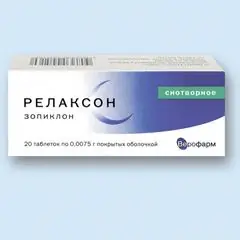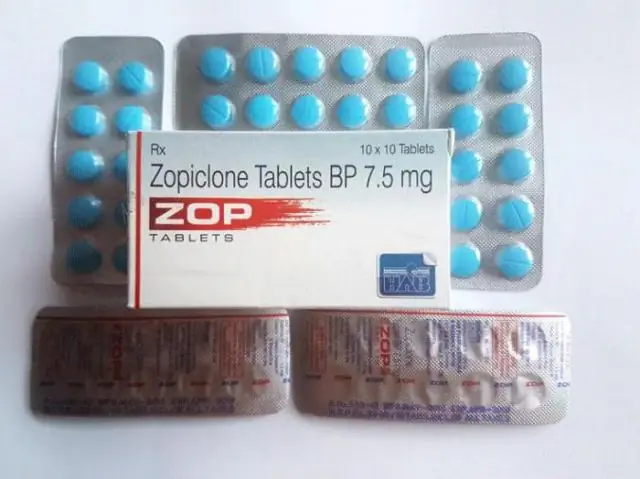- Author Rachel Wainwright [email protected].
- Public 2023-12-15 07:39.
- Last modified 2025-11-02 20:14.
Relaxon
Relaxon: instructions for use and reviews
- 1. Release form and composition
- 2. Pharmacological properties
- 3. Indications for use
- 4. Contraindications
- 5. Method of application and dosage
- 6. Side effects
- 7. Overdose
- 8. Special instructions
- 9. Application during pregnancy and lactation
- 10. Use in childhood
- 11. In case of impaired renal function
- 12. For violations of liver function
- 13. Use in the elderly
- 14. Drug interactions
- 15. Analogs
- 16. Terms and conditions of storage
- 17. Terms of dispensing from pharmacies
- 18. Reviews
- 19. Price in pharmacies
Latin name: Relaxon
ATX code: N05CF01
Active ingredient: zopiclone (zopiclone)
Producer: Veropharm OJSC (Russia)
Description and photo updated: 2019-27-08

Relaxon is a sleeping pill.
Release form and composition
Dosage form - film-coated tablets: round, convex on both sides, white (in blisters of 5 or 10 tablets, in a cardboard box 1, 2, 3 or 4 packs; 5 or 20 tablets in dark glass cans, in a pack of cardboard 1 can; each pack also contains instructions for the use of Relaxon).
Active ingredient: zopiclone - 7.5 mg in 1 tablet.
Additional components: sodium carboxymethyl starch (primogel), macrogol 4000 (polyethylene glycol 4000), magnesium stearate, lactose (milk sugar), talc, methyloxypropyl cellulose, titanium dioxide, colloidal silicon dioxide (aerosil), microcrystalline cellulose, povidone (polyvinylpyr.)
Pharmacological properties
Pharmacodynamics
The active ingredient in Relaxon is zopiclone, a hypnotic from the group of cyclopirrolones, which are structurally different from barbiturates and benzodiazepines.
The drug has a hypnotic, sedative, muscle relaxant, anticonvulsant and tranquilizing effect. These effects are due to its influence on the receptors of the central nervous system (CNS), related to the macromolecular complex of gamma-aminobutyric acid (GABA): zopiclone modulates the opening of channels for chlorine ions, as a result of which the inhibitory effect of GABA increases and interneuronal transmission in various parts of the central nervous system is inhibited.
Zopiclone shortens the time before falling asleep, reduces the number of night wakes, increases the duration of sleep and its quality, improves awakening. At the same time, it almost does not cause post-somnic disturbances, such as a feeling of sleepiness and fatigue in the morning.
Relaxon is not addictive for a long time, up to 17 weeks of taking the drug.
Pharmacokinetics
After oral administration, zopiclone is rapidly absorbed. The maximum plasma concentration (Cmax) reaches within 1.5-2 hours. After taking doses of 3.75 and 7.5 mg, Cmax is 30 and 60 ng / ml, respectively. Food does not affect the degree of absorption of the drug.
About 45% of the dose is bound to plasma proteins. With repeated doses, the drug does not cumulate.
Interindividual differences in the pharmacokinetics of zopiclone are insignificant.
It is metabolized to form an N-oxide derivative and an N-desmethyl metabolite.
The half-life after taking a dose of 3.75 and 7.5 mg is 4.5 and 7.4 hours, respectively. It is excreted: with urine - about 80% of the dose, mainly in the form of metabolites, with feces - about 16%.
In elderly patients, the half-life of the drug increases slightly, however, the cumulation of the substance in them was not detected even in the case of repeated administration.
In renal failure, zopiclone and its metabolites do not accumulate in the body even with prolonged use of Relaxon.
In patients with liver cirrhosis, the clearance of zopiclone decreases by about 40%.
Indications for use
Relaxon is a drug used for situational, transient and chronic insomnia of various etiologies (including difficulties with falling asleep, nocturnal and early awakenings).
Contraindications
- Sleep apnea syndrome;
- Severe respiratory failure;
- Severe myasthenia gravis;
- Severe liver failure;
- Age under 18;
- Pregnancy and lactation period;
- Hypersensitivity to the components of Relaxon.
Relaxon, instructions for use: method and dosage
Relaxon tablets should be taken at bedtime, 1 pc. In some cases, the dose may be increased to 2 tablets.
The duration of treatment for transient insomnia is 2-5 days, situational - 2-3 weeks.
The duration of therapy for chronic insomnia is determined individually.
The drug should not be taken for more than 4 consecutive weeks. Extension of the treatment period is possible only after re-evaluating the patient's condition.
Elderly people, patients with impaired liver function and chronic pulmonary insufficiency are recommended to start therapy with ½ tablet. In some cases, the doctor may increase the dose to 1 tablet.
Patients with renal insufficiency are prescribed ½ tablets.
Side effects
The most common side effect of Relaxone is a bitter taste in the mouth.
Other possible adverse reactions:
- From the side of the central nervous system: residual drowsiness after waking up, headache, dizziness;
- From the digestive system: dyspepsia, dry mouth, nausea;
- Allergic skin reactions: itching, skin rashes; extremely rarely - anaphylactic and angioneurotic reactions;
- Mental and paradoxical reactions: rarely - depressed mood, confusion, irritability, impaired coordination of movements, hallucinations, confusion, aggressiveness, nightmares, inappropriate behavior with possible development of amnesia, depressive state;
- Others: rarely - withdrawal syndrome, rebound insomnia; isolated cases - a slight increase in serum transaminases and / or alkaline phosphatase.
Overdose
In the case of an overdose of Relaxon, symptoms of CNS depression of varying severity are usually observed - from drowsiness to coma, depending on the dose taken.
As a first aid measure, it is recommended to do a gastric lavage and take activated charcoal. In the future, if required, in a hospital, symptomatic and supportive therapy is carried out, paying special attention to the cardiovascular and respiratory systems.
Zopiclone is characterized by a large volume of distribution, so hemodialysis is ineffective. Flumazenil can be prescribed as an antidote.
special instructions
With nocturnal attacks of bronchial asthma in patients receiving methylxanthine drugs (for example, theophylline), Relaxon cuts asthma attacks in the early morning hours, reduces their duration and intensity.
Despite the minimal risk, when prescribing Relaxon, one should take into account the likelihood of addiction and drug abuse. The risk arises in the following cases:
- Violation of the dose and / or duration of therapy;
- Abuse of other drugs and / or alcohol;
- Concomitant use of other psychotropic drugs and / or alcohol.
In rare cases, anterograde amnesia occurs, especially when nighttime sleep is interrupted and after a long period of time between taking Relaxon and going to bed. To reduce the risk of amnesia, it is recommended that you take the tablet right before bed and ensure that you have a minimum of 6 hours of sleep.
Zopiclone can mask symptoms of depression.
After the end of treatment, especially long-term, there is a likelihood of developing rebound insomnia and withdrawal syndrome, therefore Relaxon should not be abruptly canceled, it is necessary to gradually reduce the dose.
Influence on the ability to drive vehicles and complex mechanisms
Relaxon can have a negative effect on the speed of reactions and the ability to concentrate, therefore, during the period of therapy, it is recommended, if possible, to refuse to drive a car and perform potentially hazardous types of work or to take special care.
Application during pregnancy and lactation
Relaxon is not recommended for use during pregnancy and lactation.
Pediatric use
The drug is contraindicated in children and adolescents under 18 years of age.
With impaired renal function
For patients with renal insufficiency, at the beginning of therapy, the drug is prescribed at a dose of 3.75 mg (½ tablet).
For violations of liver function
Relaxon tablets are contraindicated for severe hepatic impairment.
For patients with impaired liver function at the beginning of therapy, the drug is prescribed at a dose of 3.75 mg.
Use in the elderly
Elderly patients are recommended to start treatment with a dose of 3.75 mg.
Drug interactions
During treatment, you should stop drinking alcohol, as it enhances the sedative effect.
Zopiclone reduces the concentration of trimipramine in blood plasma.
An increase in the depressing effect on the central nervous system is noted in the case of the simultaneous use of the following drugs: other hypnotics, antipsychotics, tranquilizers, sedatives, antidepressants, antiepileptic drugs, narcotic analgesics, anesthetics, antihistamines with a sedative effect, erythromycin.
Analogs
The analogues of Relaxon are: Imovan, Somnol, Zolinox, Zopiclon, Milovan, Piklodorm, Slipwell, Thorson.
Terms and conditions of storage
Store away from light and moisture, out of reach of children.
The shelf life is 3 years.
Terms of dispensing from pharmacies
Dispensed by prescription.
Reviews about Relaxon
According to reviews, Relaxon is an effective hypnotic drug of a new generation that significantly improves sleep quality, is well tolerated, does not cause addiction with prolonged use, does not contribute to the development of postsomnic effects (drowsiness and weakness in the morning), does not affect daytime activity.
Of the negative reports, the often mentioned side effect in the form of a long-lasting bitter taste in the mouth after taking the pill can be noted.
The price of Relaxon in pharmacies
The approximate price for Relaxon is 104-146 rubles. per pack of 20 film-coated tablets at a dosage of 7.5 mg.

Maria Kulkes Medical journalist About the author
Education: First Moscow State Medical University named after I. M. Sechenov, specialty "General Medicine".
Information about the drug is generalized, provided for informational purposes only and does not replace the official instructions. Self-medication is hazardous to health!






